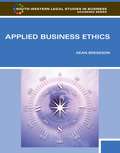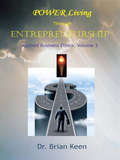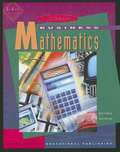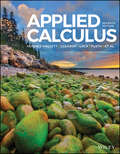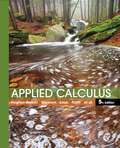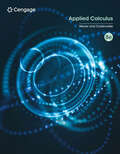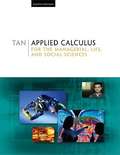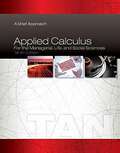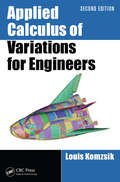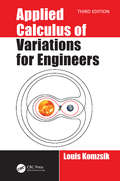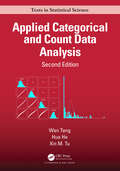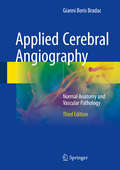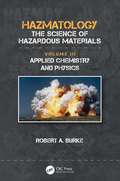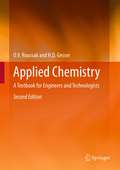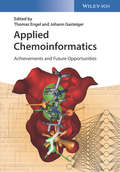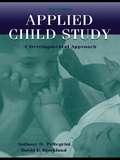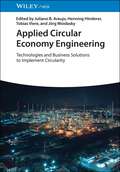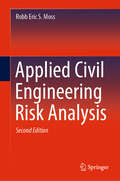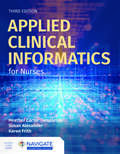- Table View
- List View
Applied Business Ethics
by Dean A. BredesonThe text applies practical ethical situations to real-world business settings and decisions. The text contains thought-provoking scenarios with up-to-the-minute issues that encourage active debate among peers.
Applied Business Ethics, Volume 2: POWER Living Through Entrepreneurship
by Dr Brian KeenThis is the second book in the Applied Business Ethics series. The first volume featured the Truth, while this volume features Entrepreneurship. The Theanthropic Ethical category is one of the few scientific ethical categories. Entrepreneurs will appreciate the fact that our work is evaluated by a fellow entrepreneur, who is an ethicist by profession. Entrepreneurs drive our business communities through resolving problems. This creates wealth for all stakeholders. All successful entrepreneurs establish enterprises that are based on ethical standards. For entrepreneurs the best ethical standards are based upon scientifically verifiable, objective standards. Theanthropic Ethics© is one of the few ethical categories that entrepreneurs can depend on. Through case studies of Canadian enterprises started by entrepreneurs, you will see how some enterprises have achieved success for centuries. All were initially successful because they implemented ethical standards. Theanthropic Ethics© is thoroughly evaluated within the context of entrepreneurship. You will see that freedom is an essential component for all entrepreneurs to become successful. Three Canadian enterprises are evaluated as case studies to show the benefits of being ethical.
Applied Business Mathematics
by Robert A. Schultheis Raymond M. KaczmarskiHelps students to assess what they've learned by providing excercises pertaining to what was learned in each chapter. Includes true/false, short answer, multiple choice, etc. questions.
Applied Business Mathematics (14th Edition)
by Robert A. Schultheis Raymond M. KaczmarskiThis classic, newly-revised book presents fundamental mathematics in the context of business and consumer applications to help put readers on the path to success. The all-new 1997 edition improves upon previous editions with a wealth of updated features. The material in Applied Business Mathematics will teach the student, the mathematical and critical thinking skills that will help him be a smart shopper, an informed citizen, and a valued employee.
Applied Calculus
by Eric Connally Karen Rhea Deborah Hughes-Hallett Daniel E. Flath Andrew M. Gleason Brigitte Lahme Patti Frazer Lock Douglas Quinney David O. Lomen David Lovelock Jeff Tecosky-Feldman Thomas W. Tucker Adam H. Spiegler William G. McCallum Brad G. Osgood Guadalupe I. Lozano Cody L. Patterson Aaron D. Wootton Ayşe Şahin Selin KalaycıoğluApplied Calculus
by Deborah Hughes-Hallett Daniel E. Flath Andrew M. Gleason Patti Frazer LockA text for interactive Calculus courses, featuring innovative problems This sixth edition of Applied Calculus engages students with well-constructed problems and content to deepen understanding. The Rule of Four approach is supported in the text, where concepts are presented graphically, numerically, symbolically, and verbally. Students with a range of learning styles will be able to progress in the subject as they are exposed to a range of exercises.
Applied Calculus
by Hughes-HallettApplied Calculus is praised for the creative and varied conceptual and modeling problems which motivate and challenge students. The 5th Edition of this market leading text exhibits the same strengths from earlier editions including the "Rule of Four," an emphasis on concepts and modeling, exposition that students can read and understand and a flexible approach to technology. Updated data and fresh applications throughout the book are designed to build student confidence with basic concepts and to reinforce skills. As in the previous edition, a Pre-test is included for students whose skills may need a refresher prior to taking the course.
Applied Calculus
by Steven R. Costenoble Stefan WanerLearn how to think and act like an effective marketer and forward-focused disruptor in today's dynamic, fast-paced business environment with Ferrell/Hartline/Hochstein’s MARKETING STRATEGY, 8E. You learn to develop long-term, customer-oriented marketing strategy and successful marketing plans with this edition's systematic, reader-friendly approach. The latest examples from organizations as familiar as Spotify, Nintendo and Microsoft work with updated vignettes and the latest research and data. New cases from Tesla, Netflix and even the recent COVID-19 pandemic clearly illustrate the need for marketers to think proactively and anticipate change. You examine today's trends, from strategic digital marketing tools and integrated marketing communication to new marketing models. This edition also discusses product labeling, social media segmentation, crisis preparedness and innovation in global marketing as you learn to analyze, plan and implement effective marketing strategies.
Applied Calculus for the Managerial, Life, and Social Sciences
by S. T. TanWell known for accuracy, Soo Tan's APPLIED CALCULUS FOR THE MANAGERIAL, LIFE, AND SOCIAL SCIENCES, Eighth Edition balances applications, pedagogy, and technology to provide students the context they need to stay motivated in the course and interested in the material. Accessible for majors and non-majors alike, the text uses an intuitive approach that introduces abstract concepts through examples drawn from common, real-life experiences to which students can relate. It also draws applications from readers' fields of interest. In addition, insightful Portfolios highlight the careers of real people and discuss how they incorporate math into their daily operations. Numerous exercises-including new Diagnostic Tests-ensure students have a solid understanding of concepts before advancing to the next topic. Algebra review notes, keyed to the review chapter Preliminaries, appear where students need them, when they need them. Bringing powerful resources to students' fingertips, the text's exciting array of supplements, including Enhanced Web Assign, equips students with extensive learning support to help them maximize their study time.
Applied Calculus for the Managerial, Life, and Social Sciences
by Soo T. TanWell known for accuracy, Soo Tan's APPLIED CALCULUS FOR THE MANAGERIAL, LIFE, AND SOCIAL SCIENCES, Eighth Edition balances applications, pedagogy, and technology to provide students the context they need to stay motivated in the course and interested in the material. Accessible for majors and non-majors alike, the text uses an intuitive approach that introduces abstract concepts through examples drawn from common, real-life experiences to which students can relate. It also draws applications from readers' fields of interest. In addition, insightful Portfolios highlight the careers of real people and discuss how they incorporate math into their daily operations. Numerous exercises-including new Diagnostic Tests-ensure students have a solid understanding of concepts before advancing to the next topic. Algebra review notes, keyed to the review chapter Preliminaries, appear where students need them, when they need them. Bringing powerful resources to students' fingertips, the text's exciting array of supplements, including Enhanced Web Assign, equips students with extensive learning support to help them maximize their study time.
Applied Calculus for the Managerial, Life, and Social Sciences: A Brief Approach
by Soo TanAPPLIED CALCULUS FOR THE MANAGERIAL, LIFE, AND SOCIAL SCIENCES: A BRIEF APPROACH, Tenth Edition balances modern applications, solid pedagogy, and the latest technology to engage students and keep them motivated in the course. Suitable for majors and non-majors alike, the text uses an intuitive approach that teaches concepts through examples drawn from real-life situations from students' fields of interest. In addition, insightful Portfolios highlight the careers of real people and discuss how they incorporate math into their daily professional activities. Numerous exercises, including a Diagnostic Test, ensure that students have a concrete understanding of concepts before advancing to the next topic. The text's pedagogical features coupled with an exciting array of supplements equip students with the tools they need to make the most of their study time and to succeed in the course.
Applied Calculus of Variations for Engineers
by Louis KomzsikThe purpose of the calculus of variations is to find optimal solutions to engineering problems whose optimum may be a certain quantity, shape, or function. Applied Calculus of Variations for Engineers addresses this important mathematical area applicable to many engineering disciplines. Its unique, application-oriented approach sets it apart from the theoretical treatises of most texts, as it is aimed at enhancing the engineer’s understanding of the topic.This Second Edition text:Contains new chapters discussing analytic solutions of variational problems and Lagrange-Hamilton equations of motion in depthProvides new sections detailing the boundary integral and finite element methods and their calculation techniquesIncludes enlightening new examples, such as the compression of a beam, the optimal cross section of beam under bending force, the solution of Laplace’s equation, and Poisson’s equation with various methodsApplied Calculus of Variations for Engineers, Second Edition extends the collection of techniques aiding the engineer in the application of the concepts of the calculus of variations.
Applied Calculus of Variations for Engineers, Third edition
by Louis KomzsikCalculus of variations has a long history. Its fundamentals were laid down by icons of mathematics like Euler and Lagrange. It was once heralded as the panacea for all engineering optimization problems by suggesting that allone needed to do was to state a variational problem, apply the appropriate Euler-Lagrange equation and solve the resulting differential equation. This, as most all encompassing solutions, turned out to be not always true and the resulting differential equations are not necessarily easy to solve. On the other hand, many of the differential equations commonly used in various fields of engineering are derived from a variational problem. Hence it is an extremely important topic justifying the new edition of this book. This third edition extends the focus of the book to academia and supports both variational calculus and mathematical modeling classes. The newly added sections, extended explanations, numerous examples and exercises aid the students in learning, the professors in teaching, and the engineers in applying variational concepts.
Applied Categorical and Count Data Analysis (Chapman & Hall/CRC Texts in Statistical Science)
by Wan Tang Hua He Xin M. TuDeveloped from the authors’ graduate-level biostatistics course, Applied Categorical and Count Data Analysis, Second Edition explains how to perform the statistical analysis of discrete data, including categorical and count outcomes. The authors have been teaching categorical data analysis courses at the University of Rochester and Tulane University for more than a decade. This book embodies their decade-long experience and insight in teaching and applying statistical models for categorical and count data. The authors describe the basic ideas underlying each concept, model, and approach to give readers a good grasp of the fundamentals of the methodology without relying on rigorous mathematical arguments. The second edition covers classic concepts and popular topics, such as contingency tables, logistic regression models, and Poisson regression models, along with modern areas that include models for zero-modified count outcomes, parametric and semiparametric longitudinal data analysis, reliability analysis, and methods for dealing with missing values. As in the first edition, R, SAS, SPSS, and Stata programming codes are provided for all the examples, enabling readers to immediately experiment with the data in the examples and even adapt or extend the codes to fit data from their own studies. Designed for a one-semester course for graduate and senior undergraduate students in biostatistics, this self-contained text is also suitable as a self-learning guide for biomedical and psychosocial researchers. It will help readers analyze data with discrete variables in a wide range of biomedical and psychosocial research fields. Features: -Describes the basic ideas underlying each concept and model. -Includes R, SAS, SPSS and Stata programming codes for all the examples -Features significantly expanded Chapters 4, 5, and 8 (Chapters 4-6, and 9 in the second edition. -Expands discussion for subtle issues in longitudinal and clustered data analysis such as time varying covariates and comparison of generalized linear mixed-effect models with GEE.
Applied Cerebral Angiography: Normal Anatomy and Vascular Pathology
by Gianni Boris BradacThis book offers detailed guidance on the diagnostic use of cerebral angiography based on precise description of the angiographic appearances of normal anatomy and pathological conditions. In this third edition, every chapter has been thoroughly revised and enlarged to reflect new knowledge and experiences, and more attention is paid to the correlations between anatomopathological findings and clinical manifestations. Beyond explaining the diagnostic value of cerebral angiography, a key aim is to equip readers with the precise knowledge of the anatomy of cerebral vessels required for optimal application of endovascular therapy of pathologies involving the arteries and veins of the brain. As in preceding editions, the book is divided into two parts. The first part describes the normal anatomy, with attention to morphological aspects, embryological development, function, and vascular territories. The intraorbital and extracranial vascularization is also fully considered. The knowledge provided will serve as a sound basis for the correct interpretation of pathological processes and their clinical significance, as covered in depth in the second part of the book.
Applied Chemistry and Physics
by Robert A. BurkeWritten by a hazardous materials consultant with over 40 years of experience in emergency services, the five-volume Hazmatology: The Science of Hazardous Materials suggests a new approach dealing with the most common aspects of hazardous materials, containers, and the affected environment. It focuses on innovations in decontamination, monitoring instruments, and personal protective equipment in a scientific way, utilizing common sense, and takes a risk-benefit approach to hazardous material response. This set provides the reader with a hazardous materials "Tool Box" and a guide for learning which tools to use under what circumstances.Dealing with hazardous materials incidents cannot be accomplished effectively and safely without knowing the effects these materials have. Volume Three, Applied Chemistry and Physics, is not about teaching chemistry and physics. It is about presenting these topics at the level that emergency responders will understand so they can apply the concepts using a risk management system. FEATURES Uses a scientific approach utilizing analysis of previous incidents Offers a risk-benefit approach based upon science and history Provides understanding tools for your Hazmat Tool Box Simplifies physical and chemical characteristics Utilizes chemistry and physics to identify hazards to responders
Applied Chemistry: A Textbook for Engineers and Technologists
by Oleg Roussak H. D. GesserThe second edition of Gesser's classic Applied Chemistry includes updated versions of the original 16 chapters plus two new chapters on semiconductors and nanotechnology. This textbook introduces chemistry students to the applications of their field to engineering design and function across a wide range of subjects, from fuels and polymers to electrochemistry and water treatment. Each chapter concludes with a reading list of relevant books and articles as well as a set of exercises which include problems that extend the topics beyond the text. Other supplements to the text include a laboratory section with step-by-step experiments and a solutions manual for instructors.
Applied Chemoinformatics: Achievements and Future Opportunities
by Thomas Engel Johann GasteigerEdited by world-famous pioneers in chemoinformatics, this is a clearly structured and applications-oriented approach to the topic, providing up-to-date and focused information on the wide range of applications in this exciting field.The authors explain methods and software tools, such that the reader will not only learn the basics but also how to use the different software packages available. Experts describe applications in such different fields as structure-spectra correlations, virtual screening, prediction of active sites, library design, the prediction of the properties of chemicals, the development of new cosmetics products, quality control in food, the design of new materials with improved properties, toxicity modeling, assessment of the risk of chemicals, and the control of chemical processes.The book is aimed at advanced students as well as lectures but also at scientists that want to learn how chemoinformatics could assist them in solving their daily scientific tasks.Together with the corresponding textbook Chemoinformatics - Basic Concepts and Methods (ISBN 9783527331093) on the fundamentals of chemoinformatics readers will have a comprehensive overview of the field.
Applied Child Study: A Developmental Approach
by David F. Bjorklund Anthony D. PellegriniChild study is a very complex field. Human beings, and children, specifically, are very complex beings. Consequently, simple answers and solutions to problems are very often just that: too simple. This text presents principles and methods for studying children in the varied contexts in which they live and function. These theories and methods can be used as a kind of "tool kit" for application in a variety of situations by the people who work with children such as researchers, parents, educators, pediatricians, nurses, social workers, and child psychologists, to name but a few. In short, the book is written for people interested in how to examine and describe children as well as those interested in creating educational environments for children.
Applied Choice Analysis
by William H. Greene David A. Hensher John M. RoseAlmost without exception, everything human beings undertake involves a choice. In recent years there has been a growing interest in the development and application of quantitative statistical methods to study choices made by individuals with the purpose of gaining a better understanding both of how choices are made and of forecasting future choice responses. In this primer the authors provide an unintimidating introduction to the main techniques of choice analysis and include detail on themes such as data collection and preparation, model estimation and interpretation and the design of choice experiments. A companion website to the book provides practice data sets and software to estimate the main discrete choice models such as multinomial logit, nested logit and mixed logit. This primer will be an invaluable resource to students as well as of immense value to consultants and professionals, researchers and anyone else interested in choice analysis and modelling.
Applied Choice Analysis
by William H. Greene David A. Hensher John M. Rose David A. Hensher John M. RoseIn recent years, there has been growing interest in the development and application of quantitative statistical methods to study choices made by individuals. This primer provides an introduction to the main techniques of choice analysis and also includes details on data collection and preparation, model estimation and interpretation and the design of choice experiments. A companion website offers practice data sets and software to apply modeling and data skills presented in the book.
Applied Circular Economy Engineering: Technologies and Business Solutions to Implement Circularity
by Tobias Viere Juliano B. Araujo Henning Hinderer Jörg WoidaskyAn essential resource for circular economy engineering as a business sustainability solution and risk mitigation measure In Applied Circular Economy Engineering: Technologies and Business Solutions to Implement Circularity, a team of distinguished researchers delivers an up-to-date discussion of the implementation of circular economy concepts in industrial practice. It examines a comprehensive range of solutions and ideas from engineering and business research from the perspective of the European Circular Economy Package. The book explores the most relevant material and product flows, including metals, polymers, and food, as well as common product lifecycle steps, like product design, material extraction, and recycling. Applied Circular Economy Engineering explains the most effective applied practices, business considerations, and forward-looking solutions to frequently experienced business problems. Readers will also find: A thorough introduction to how circular economy considerations influence process design, product design, energy, and waste managementReal-world case studies of circular design and processesPractical discussions of a wide variety of industries adopting circular economy principles, including medical devices and foodComplete treatments of circular economy implementation and challenges, including business circularity maturity assessments and transition plans Perfect for chemical and process engineers, Applied Circular Economy Engineering: Technologies and Business Solutions to Implement Circularity will also benefit business economists, product planners, and anyone else involved in the engineering and development of circular products or processes.
Applied Civil Engineering Risk Analysis
by Robb Eric MossThis updated edition retains its introduction to applied fundamental statistics, probability, reliability, and decision theory as these pertain to problems in Civil Engineering. The new edition adds an expanded treatment of systems reliability, Bayesian methods, and spatial variabililty, along with additional example problems throughout. The book provides readers with the tools needed to determine the probability of failure, and when multiplied by the consequences of failure, illustrates how to assess the risk of civil engineering problems. Presenting methods for quantifying uncertainty that exists in engineering analysis and design, with an emphasis on fostering more accurate analysis and design, the text is ideal for students and practitioners of a range of civil engineering disciplines. Expands on the class-tested pedagogy from the first edition with more material and more examples;Broadens understanding with simulations coded both in Matlab and in R; Features new chapters on spatial variability and Bayesian methods;Emphasizes techniques for estimating the influence of uncertainty on the probability of failure
Applied Climatology: Principles and Practice
by Allen Perry Dr Russell Thompson Russell Thompson'Big freeze' conditions, storms, severe flooding, droughts, and heatwaves - recent extremes in weather, with their resultant physical, economic and human losses, highlight the vulnerability of society to changes in the atmosphere. Atmospheric pollution, urbanization, natural atmospheric disasters are causing dramatic changes in climatic environments.Applied Climatology examines the effects of climate on physical, biological and cultural environments. Specialist contributors from Europe, North America and Australasia examine the impacts of changing climates on the functioning and development of physical biological environments including glaciers, water resources, landforms, soils, vegetation and animals.Weather and climate effects day-to-day activities and lifestyles from the clothes we wear to the buildings we design, and the food and energy we produce. This book focusses on the relationship between climate and a wide range of human activities and responses relating to health and comfort, building design, transport systems, agriculture and fisheries, tourism and social, industrial and legal issues.Climate-environment relationships and impacts on human activities are predicted to change dramatically if global warming accelerates at the rates currently proposed. Applied Climatology examines the characteristics and consequences of the changing global climate and considers the future for both natural and human environments.
Applied Clinical Informatics for Nurses
by Heather Carter-Templeton Susan Alexander Karen FrithNurses need to be aware of the latest information, technologies, and research available to provide safe, patient-centered, evidence-based care. Applied Clinical Informatics for Nurses continues its' student-centered approach to nursing informatics in a modern new edition full of illustrations, tables, figures, and boxes that enhance the readers’ experience and assists in comprehension. In the updated Third Edition, the authors emphasize the importance of understanding principles and applications of informatics and apply a context-based teaching approach to enhance clinical decision-making, promote ethical conduct, and improve problem-solving skills. The Third Edition features extensive updates on telehealth, mobile health, and clinical decision support. It also includes expanded information related to software used for data mining and additional case studies to help illustrate creative informatics projects developed by nurses.
